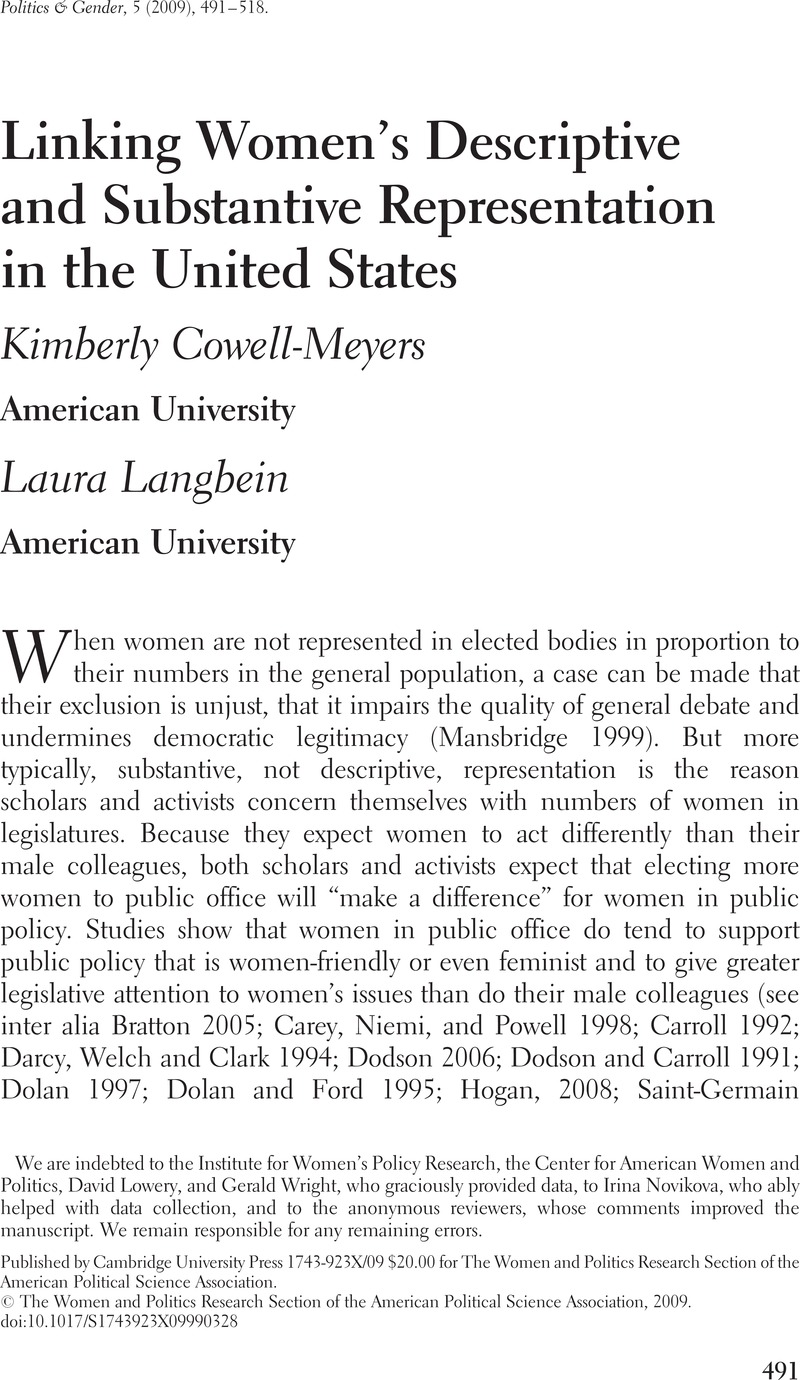Crossref Citations
This article has been cited by the following publications. This list is generated based on data provided by Crossref.
Celis, Karen
and
Childs, Sarah
2011.
Rightist Parties and Women’s Substantive Representation.
SSRN Electronic Journal,
Celis, Karen
and
Childs, Sarah
2012.
The Substantive Representation of Women: What to Do with Conservative Claims?.
Political Studies,
Vol. 60,
Issue. 1,
p.
213.
Reingold, Beth
and
Smith, Adrienne R.
2012.
Welfare Policymaking and Intersections of Race, Ethnicity, and Gender in U.S. State Legislatures.
American Journal of Political Science,
Vol. 56,
Issue. 1,
p.
131.
Wittmer, Dana E.
and
Bouché, Vanessa
2013.
The Limits of Gendered Leadership: Policy Implications of Female Leadership on “Women's Issues”.
Politics & Gender,
Vol. 9,
Issue. 03,
p.
245.
Cowell-Meyers, Kimberly
and
Langbein, Laura
2013.
Measuring Women-Friendly Policy in the American States.
Journal of Women, Politics & Policy,
Vol. 34,
Issue. 2,
p.
159.
Briskin, Linda
2014.
Strategies to support equality bargaining inside unions: Representational democracy and representational justice.
Journal of Industrial Relations,
Vol. 56,
Issue. 2,
p.
208.
Shah, Shaheen Ashraf
2014.
Women, Political Struggles and Gender Equality in South Asia.
p.
175.
Debus, Marc
and
Hansen, Martin Ejnar
2014.
Representation of Women in the Parliament of the Weimar Republic: Evidence from Roll Call Votes.
Politics & Gender,
Vol. 10,
Issue. 3,
p.
341.
Osborn, Tracy
2014.
Women State Legislators and Representation.
State and Local Government Review,
Vol. 46,
Issue. 2,
p.
146.
Cowell-Meyers, Kimberly B.
2014.
The Social Movement as Political Party: The Northern Ireland Women's Coalition and the Campaign for Inclusion.
Perspectives on Politics,
Vol. 12,
Issue. 1,
p.
61.
Smith, Adrienne R.
2014.
Cities Where Women Rule: Female Political Incorporation and the Allocation of Community Development Block Grant Funding.
Politics & Gender,
Vol. 10,
Issue. 3,
p.
313.
Reingold, Beth
and
Smith, Adrienne
2014.
Legislative Leadership and Intersections of Gender, Race, and Ethnicity in the American States.
SSRN Electronic Journal,
Bouché, Vanessa
and
Wittmer, Dana E.
2015.
Gendered diffusion on gendered issues: the case of human trafficking.
Journal of Public Policy,
Vol. 35,
Issue. 1,
p.
1.
Heidbreder, Brianne
2016.
Change and Continuity in the Study of State and Local Governance.
State and Local Government Review,
Vol. 48,
Issue. 1,
p.
63.
Allen, Peter
and
Cutts, David
2016.
Exploring sex differences in attitudes towards the descriptive and substantive representation of women.
The British Journal of Politics and International Relations,
Vol. 18,
Issue. 4,
p.
912.
Niven, David
and
Panagopoulos, Costas
2016.
Does Candidate Sexual Orientation Matter at the Ballot Box? A Field Experiment.
SSRN Electronic Journal ,
McEvoy, Caroline
2016.
Does the Descriptive Representation of Women Matter? A Comparison of Gendered Differences in Political Attitudes between Voters and Representatives in the European Parliament.
Politics & Gender,
Vol. 12,
Issue. 4,
p.
754.
Hänni, Miriam
2017.
Responsiveness – To Whom? Why the Primacy of the Median Voter Alienates Minorities.
Political Studies,
Vol. 65,
Issue. 3,
p.
665.
Pyeatt, Nicholas
and
Yanus, Alixandra B.
2017.
Increasing Women’s Political Participation: The Role of Women-Friendly Districts.
Representation,
Vol. 53,
Issue. 3-4,
p.
185.
Patton, Dana J
and
Fording, Richard C
2017.
The Politics of Death: The Effect of Women's Descriptive Representation on Mortality.
SSRN Electronic Journal ,



